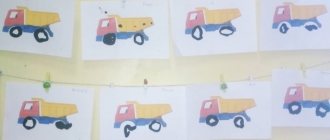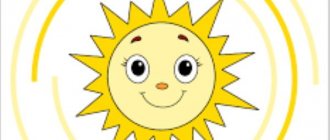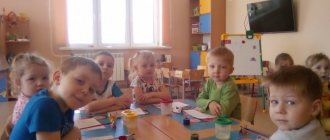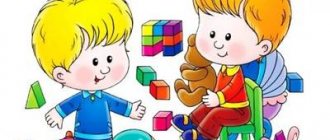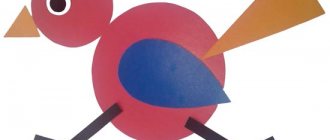Long-term plan for artistic and aesthetic development in the second junior group
Tatiana Romancheva
Long-term plan for artistic and aesthetic development in the second junior group
PERSPECTIVE PLAN FOR ARTISTIC AND AESTHETIC DEVELOPMENT
IN THE SECOND JUNIOR GROUP "TEREMOK"
Date Topic of the week GCD Goal, objectives Source
3.09 “Adaptation-vacation week”
“Acquaintance with pencil and paper”
.
Learn to draw with colored pencils, hold them correctly, and move them across the paper, leaving a visible mark. Cultivate a desire to draw. N. S. Golitsyna “Notes of complex thematic classes 2ml.
gr." page 11
5.09 “Adaptation-vacation week”
“Let’s remember how objects should lie on the table
. Introduce the organization of an application lesson. Introduce the rules of safe behavior in class. Learn to create images from ready-made shapes, laying them out on a sheet of paper. N. S. Golitsyna page 17
10.09 “Adaptation-vacation week”
“Balls for kittens”
.
Learn to draw round objects with a foam rubber swab and carefully paint over them. D. N. Koldina “Drawing with children 3-4 years old”
p. 11
11.09 “Adaptation and vacation week “Toys”
. Arouse interest in modeling from plasticine. Introduce the properties of plasticine. Learn to roll out a ball of plasticine and decorate the sculpted product with additional material. D. N. Koldina page 12
17.09 "Kindergarten"
.
“Let’s draw strings for the balloons
. Reinforce knowledge of flower names. Learn to draw straight lines with a pencil from top to bottom, draw the line continuously, leaving a visible mark. N. S. Golitsyna page 16
18.09 "Kindergarten"
.
"The balls are rolling along the path
.
Learn gluing techniques - take a little glue, spread the back of the workpiece on the oilcloth, press it to the sheet with a cloth. N. S. Golitsyna p. 32 (application)
09.24 “Our favorite kindergarten”
.
“These are sorceresses - multi-colored paints
. Introduce a new visual material - paints. Learn to draw lines, remove excess paint from the brush, and rinse it in water. N. S. Golitsyna page 30
25.09 "Our favorite kindergarten"
.
"Mushroom clearing"
.
Teach children to roll out small balls of plasticine into columns and connect them with additional material. Cultivate kindness and responsiveness. D. N. Koldina “Modeling with children 3-4 years old”
p. 16
1.10 Rain
.
Continue drawing straight lines with a pencil from top to bottom, drawing the lines continuously, leaving a visible mark. Learn to draw short strokes and hold a pencil correctly. N. S. Golitsyna p. 25 (drawing)
2.10 Monitoring “Let’s put the pies in a vase”
.
Practice using gluing techniques. Develop the ability to arrange parts in an aesthetic order. N. S. Golitsyna p. 45 (application)
8.10 Monitoring “Introduction to colored wax crayons”
Encourage them to draw with crayons without pressing too hard to avoid breaking them.
Learn how to hold it correctly and leave a visible mark on paper. N. S. Golitsyna p. 38 (drawing)
9.10 Monitoring “Bagels and Bagels”
Consolidate knowledge of names and products, strengthen the ability to roll out a plastic mass between the palms with straight movements, learn to roll a stick into a ring, tightly connecting the ends.
N. S. Golitsyna page 44 (modeling)
15.10 “Autumn”
“Autumn leaf fall”
Learn to paint with a brush using the
“dipping”
, changing the color of the paint;
strengthen the ability to hold a brush, pick up paint on the bristles, and rinse the brush. Learn to distinguish and name colors. D. N. Koldina page 16 (drawing)
16.10 “Autumn”
“Autumn trees and bushes”
To consolidate children’s knowledge about the rules of gluing, to introduce them to the color orange.
Learn to correlate color with its name. Consolidate knowledge about yellow, green, red colors. D. N. Koldina page 18 (application)
22.10 “Autumn”
“Let's collect vegetables in a bag”
We consolidate knowledge about vegetables, continue to learn how to draw oval and round objects with pencils.
N. S. Golitsyna, p. 67 (drawing)
23.10 “Autumn”
“Potatoes in a bag”
Teach children to roll small balls between their palms and flatten them on top with their fingers on cardboard, to evoke tactile sensations.
D. N. Koldina page 13 (modeling)
10.29 “Autumn”
“These are the fruits”
Reinforce the idea of the appearance of fruits.
Strengthen the ability to draw rounded shapes. Practice the skill of working with gouache. N. S. Golitsyna, p. 72 (drawing)
30.10 “Golden Autumn”
“Sun in Clouds”
Teach children to create a plot composition from a broken circle along the contour and crumpled lumps of a napkin.
Learn to glue rolled up large lumps of paper onto cardboard. D. N. Koldina page 19 (applique)
5.11 “The world around us”
“Patterns on a dress”
Continue introducing watercolor paints.
Learn to decorate products with dots, strokes, stripes, rings using a brush and paints. Develop imagination . D. N. Koldina page 19 (drawing)
6.11 “The World Around Us”
“Mittens”
Continue teaching children to apply plasticine to surfaces.
Learn to decorate products yourself, develop creativity and imagination. D. N. Koldina page 20 (modeling)
12.11 “The world around us”
“Rug for a doll”
Strengthen the ability to draw rectangular objects, decorate as desired, consolidate drawing skills with pencils and felt-tip pens.
N. S. Golitsina, p. 14 (drawing)
13.11 “The world around us”
“Blanket for a doll”
Continue to teach how to apply glue to parts and stick them on a sheet of paper.
Teaches how to make a pattern of circles on a square sheet of paper, alternating them by color. D. N. Koldina, page 22 (application)
11.19 “The world around us”
“My mother”
Learn to correctly name family members and talk about them.
Learn to draw a schematic drawing with colored pencils of a person consisting of a circle and a triangle. Add color names. D. N. Koldina, page 32 (drawing)
11/20 “The World Around Us”
“Table”
Continue rolling out the plasticine rollers.
Develop the ability to sculpt objects of the correct size. Strengthen rolling techniques between your palms. D. N. Koldina, p. 20 (modeling)
26.11 “The World Around Us”
“Striped Scarf”
Learn to draw straight lines from left to right, learn to combine colors, consolidate skills in working with gouache.
N. S. Golitsyna, p. 128 (drawing)
27.11 “The world around us”
“Scarf for a nesting doll”
Continue to teach how to apply glue to parts, stick them on a square-shaped sheet of paper.
Learn to make a pattern on a triangular scarf, alternating circles and triangles. D. N. Koldina, p. 21 (application)
3.12 “Winter”
“Hare in the Snow”
Teaches children to make pokes with a hard semi-dry brush inside the contour,
to develop imagination , creativity, fantasy. D. N. Koldina, page 29 (drawing)
4.12. “Winter”
“Snowballs - big and small”
Practice using the application technique, consolidate knowledge of the concept - big, small.
Strengthen the ability to sculpt round objects using familiar techniques. Encourage them to sculpt several objects and independently pinch off plasticine from a piece. N. S. Golitsina, p. 117 (Modeling)
10.12 “Winter”
“Coniferous forest”
Teaches you to draw objects consisting of a combination of lines; create a composition, expand children’s understanding of the coniferous forest. D. N. Koldina, p. 25
11.12 “Winter”
“Carrots for bunnies”
Reinforce the use of the application technique, teaches you to stick objects using a brush and a napkin. D. N. Koldina, p. 25
17.12 “Winter”
“Swan”
Continue to introduce children to the technique of palm printing, teach them to add details to images using a brush, and
develop their imagination . D. N. Koldina, p. 41 (drawing)
12/18 “Winter”
“Owl”
Learn to combine natural materials and plasticine in crafts.
Develop perception and attention, consolidate rolling techniques in a circular motion. D. N. Koldina, p. 38 (modeling)
24.12 “New Year’s holiday”
“We will decorate the Christmas tree for the holiday”
Learn to draw objects consisting of vertical and oblique lines.
Teaches how to draw Christmas tree needles using the poking technique. Decorate it with balls and lights. Develop aesthetic perception, improve technical techniques. Develop creativity and independence. T.V. Koroleva “Draw and Learn”
, pp. 36-38
(drawing)
12.25 “New Year’s holiday”
“Toy for the Christmas tree”
Learn to compose an image of objects from several parts, continue to teach neat gluing skills.
N. S. Golitsyna, p. 111 (application)
14.01 “The Magic World of Fairy Tales”
“Santa Claus’s Hut”
Teach children to convey the image of a fairy-tale hut in a drawing.
Learn to use cool colors and shades, depict an object from a quadrangular shape, a straight roof. Learn to make additions to a drawing by T.V. Korolev “Draw and Learn”
, pp. 39-41
(drawing)
15.01
“The magical world of fairy tales”
“The Little Mouse and the Golden Egg”
Continue to learn how to depict fairy-tale characters using plasticine.
Learn to transform a spherical shape into an oval shape with direct hand movements, using familiar sculpting methods: rolling, pulling, flattening. G. N. Davydova pp. 63-65 (modeling)
21.01
“Transport, road safety”
“Travel by car, ship, plane”
Learn to complete the missing round-shaped details on the depicted objects.
D. N. Koldina pp. 35,36 (drawing)
22.01 Transport, road safety “Traffic light”
Teach children to make circles and rectangles from pre-prepared circles, depict an object and stick it on.
D. N. Koldina pp. 37,38 (application)
28.01
Transport, road safety. "Cars are racing down the road"
Strengthen ideas about types of transport.
Encourage them to talk about their drawing. Draw rectangular and round objects, add details. N. S. Golitsyna p. 169 (drawing)
29.01 Transport, road safety. "The plane is flying"
Strengthen the ability of children to divide a block of plasticine into two equal parts by eye, and roll it out with straight movements of the palms.
Be able to assemble an object consisting of several parts on a plane and achieve an accurate representation of the object’s shape. Develop the ability to use printing and flattening techniques. G. N. Davydova, pp. 55-58 (modeling)
5.02 World of professions “Railway for Aibolit”
.
Learn to draw long and short lines in watercolor. Create a desire to help those who need help. D. N. Koldina p. 36 (drawing)
6.02 The world of professions “Elephant juggler”
.
Teach children to arrange the parts according to their color and contour shape, and stick them on. To develop an interest in circus professions. D. N. Koldina page 38 (application)
11.02 Folk art, culture, traditions. "Rainbow with Dymkovo patterns"
Continue to introduce children to folk crafts - the Dymkovo toy, its color scheme, and pattern features.
Improve technical skills in working with gouache. Learn to create a picture based on Dymkovo painting (circle, ring, dots)
.
T. V. Koroleva pp. 49-51 (drawing)
12.02 Folk art, culture, traditions “Beads for Lucy”
.
Strengthen the ability to sculpt objects from several parts, place beads close to each other, in a certain order, alternating them by color. G. N. Davydova pp. 19-21 (modeling)
18.02 Folk art, culture, traditions “Our nesting doll”
.
Improve your ability to depict rounded shapes. Learn to convey the image of a matryoshka doll. Learn to decorate with small details. T. V. Koroleva pp. 28-30 (drawing)
19.02 Folk art “Here are the funny nesting dolls, okay, okay”
Expand children's knowledge about folk craftsmen who make toys.
Arouse interest in the image, the desire to decorate the nesting doll using ready-made elements of the pattern V. N. Volchkova, N. V. Stepanova, p. 326 (applique)
25.02 My family “Mom, Dad, I am family”
Learn to correctly name family members, learn to correctly name family members, learn to draw a person schematically with colored pencils, consisting of a circle, triangle and lines, consolidate the ability to distinguish colors.
D. N. Koldina, p. 32 (drawing)
02.26 My family “Our family’s house”
Strengthen children's ability to bring products to the desired image with the help of plasticine, cultivate a sense of pride in their family.
D. N. Koldina, p. 31 (modeling)
3.03 My family “Flowers in a vase for my beloved mother”
Learn to draw a vase using round and square shapes, strengthen the drawing by poking, and improve techniques for working with paint.
T. V. Koroleva, pp. 55-57 (drawing)
4.03 My family “Mimosa”
Teach children to tear off a napkin, crumple it into a ball and stick it in the right place on a sheet of paper by D. N. Koldina, page 39
(application)
10.03 My family “Dasha’s Birthday”
Learn to independently convey your idea in a drawing, choose the appropriate drawing technique and material
(gouache, pencil, paints)
D. N. Koldina, p. 44
(drawing)
11.03 My family “Flower for Grandma”
Continue to teach how to combine natural materials and plasticine in crafts,
develop the creative abilities of children D. N. Koldina, page 39 (modeling)
17.03 I am growing healthy “Vitamins for Irinka”
Continue to reinforce the names of fruits and vegetables, learn how to paint large and small round shapes with a brush, learn how to hold a brush correctly, how to pick up paint by D. N. Koldina, pp. 13-14
(drawing)
18.03 I am growing healthy “A beautiful plate for beautiful products”
Reinforce ideas about healthy products, learn to make a pattern on a round object, place it along the edge and in the center, learn to alternate circles by color and size.
N. S. Golitsina, p. 200 (application)
24.03 Spring “Spring icicles”
Teach children to draw icicles along the length and transfer droplets with rhythmic strokes.
Strengthen the ability to analyze and understand the content of a topic. D. N. Koldina, p. 39 (drawing)
25.03 Spring “The sun woke up, smiled at the children”
Learn to convey the image of the sun, improve the ability to roll a piece of plasticine between your palms, giving it a spherical shape, and flatten it on a horizontal surface for a flat image.
G. N. Davydova, p. 23 (modeling)
31.03 Spring “Rook on the mountain - spring in the yard”
Learn to draw a bird using a round shape to depict the body and head.
Invite children to draw birds that peck grains to develop their creative abilities. T. V. Koroleva, pp. 66-68 (drawing)
1.04 Spring “Indoor flower”
Teach children to make a flower from parts, apply glue to the parts and stick them on a sheet of paper.
Develop perception and thinking. D. N. Koldina, pp. 40-41 (application)
7.04 Book Week of Humor and Laughter “Clown Mask”
Learn to draw a clown's face with a simple pencil, consisting of circles of different sizes, learn to navigate parts of the body and face.
D. N. Koldina, pp. 31-32 (drawing)
8.04 Book week of humor and laughter “Tumbler Bear”
Practice depicting objects consisting of round parts of different sizes, practice the technique of fastening parts.
T. S. Komarova, p. 38 (modeling)
14.04 Space “A rocket is flying in the starry sky”
Continue to introduce the first cosmonaut of the Earth.
Expand children's knowledge about the world of technology around them. Learn to draw a rocket using a triangular or oval shape, learn to apply small parts to the shape, and improve technical shapes. T. V. Koroleva, p. 68 (drawing)
15.04 Space “Trip to the Moon”
Learn to paste ready-made forms, be able to place them on a sheet of paper, improve the ability to complement the work, and
develop spatial arrangement. T. S. Komarova p. 37 (application)
21.04 World of nature “Birdhouse”
Learn to draw an object consisting of a rectangular shape, a circle, a straight roof.
Correctly convey the size of the parts of an object. Reinforce the painting technique. T. S. Komarova, p. 41 (drawing)
22.04 World of nature “Beautiful butterfly”
Continue to teach children to apply plasticine to the surface in a thin layer inside the outline and decorate the product.
D. N. Koldina, p. 43 (modeling)
28.04 The world of nature “Easter. Painted eggs"
Learn to draw using a stencil, paint using familiar techniques.
Develop a color scheme . D. N. Koldina. p. 42 (drawing)
29.04 The world of nature “Basket with Easter eggs”
Continue to teach children how to create a collective composition and correctly place objects on a sheet of paper.
D. N. Koldina, p. 45 (applique)
5.05 World of nature “Insects and bugs are walking”
Continue teaching children to draw familiar shapes, create a plot composition, and reinforce color names.
D. N. Koldina, p. 45 (drawing)
6.05 The world of nature “Turtle”
Arouse interest in representatives of the animal world, talk about the features of appearance. Strengthen the ability to work with plasticine: rolling out parts of an object in circular and straight movements.
Learn to connect individual parts into a single whole. G. N. Davydova, pp. 33-35 (modeling)
12.05 Blooming spring. Insects "Green bushes"
Improve children's skills in combining various technical skills.
D. N. Koldina, p. 42 (drawing)
13.05 Blooming spring. Insects "Tulip"
Continue to teach children how to make a whole from parts. Introduce the names of garden flowers and the components of plants. D. N. Koldina,
page 44 (application)
19.05 Blooming spring “Dandelions in the grass”
Teaches to convey in a drawing the beauty of a blooming meadow and the shape of flowers.
Practice painting techniques with paints. Develop the ability to enjoy your drawing. T. S. Komarova, p. 44 (drawing)
20.05 Blooming spring “Small Bird”
Learn to sculpt an object consisting of several parts, reinforce the technique of pinching with your fingertips
(beak, tail)
.
Practice the ability to press parts tightly together. T. S. Komarova, p. 40 (modeling)
26.05 Summer “Ladybug on green grass”
Learn to depict insects crawling one after another, continue to add additions to the image.
T. V. Koroleva, p. 78 (drawing)
27.05 Summer “Chicken”
Continue to teach children how to create a collective composition and bring the subject to the desired image.
D. N. Koldina, page 42 (application)
Work plan for a drawing circle in kindergarten in the second junior group
Work plan for the fine arts club at the preschool educational institution “Vesyolyaya Kistochka”. Second junior group
Description of work: I offer you a work plan for the “Merry Brush” circle for children of the second junior group. This material will be useful for educators and teachers of preschool institutions. This is a work plan for a circle to use non-traditional drawing techniques in visual arts, aimed at developing children’s creative abilities. Goal: Development of creativity in children using non-traditional drawing techniques Objectives: - expanding children's ideas about non-traditional drawing methods;
- development of fantasy and creative imagination; - development of auditory and visual perception; - development of fine motor skills of the fingers; - speech development. Work plan for the “Merry Brush” circle
September
“Introducing children to non-traditional drawing methods” Objectives:
- to introduce children to non-traditional drawing methods: spotting with additional drawing, blotography, finger painting, crumpled paper, using flares, wax, graphics, on wet paper, drawing with applique, etc. .
“Golden Autumn” Non-traditional technique:
finger painting
Objectives:
- continue to teach children to reflect the beauty of autumn nature in their drawings - draw using an unconventional drawing technique - finger painting - consolidate techniques for working with a brush - develop the creativity of O.A.
Belobrykina “Little wizards or on the way to creativity”, page 11 “The apples are ripe” Non-traditional technique:
finger painting
Objectives:
- introduce the method of depiction - finger painting - lead children to create an expressive image through volume and color - develop the imagination of O.A. .
Belobrykina “Little wizards or on the path to creativity”, page 13 “Sun” Non-traditional technique:
drawing with palms
Tasks:
- introduce children to drawing with palms - teach children to use napkins; - cultivate love for all living things M. Kudeiko “Collection of Ideas”, p. 136
October
“Autumn Landscape” Non-traditional technique:
spotting
Tasks:
- continue to teach children to reflect the beauty of autumn nature in drawings - draw using an unconventional drawing technique - spotography - develop fine motor skills of the hands;
— develop creative activity and imagination of O.A. Belobrykina “Little wizards or on the way to creativity”, p. 15 “My favorite toy” Non-traditional technique:
spotting
Tasks:
- continue to teach children to draw from an idea - learn to reflect the features of their toy using an unconventional drawing technique - spotography, and adding small details with a brush - to develop the imagination of O.A.
Belobrykina “Little wizards or on the path to creativity”, p. 15 “Golden Autumn” Non-traditional technique:
crumpled paper
Objectives:
- continue to introduce children to non-traditional drawing - learn to draw tree foliage using crumpled paper - develop the imagination and creative abilities of M. Kudeiko “Collection of ideas”, p. 132
“Artists are magicians” Non-traditional technique:
diatypia
Objectives:
- continue to teach children to reflect the beauty of autumn nature in drawings - draw using an unconventional drawing technique - diatypia - consolidate techniques for working with a brush - develop the creativity of O.A. . Belobrykina “Little wizards or on the path to creativity”, p. 10
November
“Rowan Branch” Non-traditional technique:
finger painting
Objectives:
- continue to teach children to reflect the beauty of autumn nature in drawings - draw using an unconventional drawing technique - finger painting - consolidate techniques for working with a brush - develop the creativity of M. Kudeiko “Collection of Ideas”, pp. 138
“Today we are wizards” Non-traditional technique:
blotography
Objectives:
- introduce children to blotography - develop the ability to see, peer, recognize who is “hiding” in the spot;
— consolidate drawing skills by N. F. Steinle “Art activities in kindergarten” (lesson development), p. 20 “Toy Store” Non-traditional technique:
diatypia
Tasks:
— continue to teach children to reflect the beauty of autumn nature in drawings — draw using non-traditional techniques drawing – diatypia – consolidate techniques of working with a brush – develop creativity O.A.
Belobrykina “Little wizards or on the path to creativity”, p. 10 “Bird” Non-traditional technique:
on a wet sheet
Objectives:
- consolidate knowledge about drawing on a wet sheet, teach children to draw quickly until the sheet dries - learn to draw the silhouette of a bird - cultivate love to everything living O.A. Belobrykina “Little wizards or on the path to creativity”, p. 12
December
“Sparrow” Non-traditional technique:
non-traditional drawing
Objectives:
- learn to draw with your hands, draw by printing bottle caps, jars (diameter 3-4 cm) - draw eyes with the tip of a brush;
- rejoice at the result obtained; -instill an interest in drawing. N. F. Steinle “Art activities in kindergarten” (lesson development), p. 23 “Winter has come” Non-traditional technique:
aquatype
Tasks:
- consolidate children’s knowledge about aquatype - develop the ability to create a landscape, consolidate knowledge of its features - be able to complete the drawing of small details using a brush - to develop the creative abilities of children O.A.
Belobrykina “Little wizards or on the path to creativity”, page 11 “Snowman” Non-traditional technique:
paper napkins
Tasks:
- teach children to make appliqué with additional drawing using napkins;
— develop attention and observation — consolidate the ability to work with glue. N.V. Shaidurova “Working with preschool children”, p. 29 “Fluffy Christmas tree” Non-traditional technique:
on a wet sheet
Objectives:
- consolidate knowledge about drawing on a wet sheet, teach children to draw quickly until the sheet dries - learn to draw the silhouette of a bird - cultivate love for to all living things N. F. Steinle “Visual activities in kindergarten” (lesson development), p. 36
January
“Trees in frost” Non-traditional technique:
on a wet sheet of paper
Objectives:
- consolidate children’s skills in depicting a landscape - introduce the natural phenomenon - frost - consolidate the technique of drawing on a wet sheet of paper O.A.
Belobrykina “Little wizards or on the path to creativity”, page 12 “Patterns on the window” Non-traditional technique:
diatypia [iTasks:]
- consolidate the technique of diatypia; - develop fantasy and creative imagination of O.A. Belobrykina “Little wizards or on the path to creativity”, p. 10; M. Kudeiko “Collection of Ideas”, p. 144 “Kitten” Non-traditional technique:
artist’s potato, flares, signets
Objectives:
- consolidate the ability to create animal silhouettes;
- perform work using flares, signets, using finger painting; — develop children’s creative abilities and their imagination — develop fine motor skills of the fingers N.V. Shaidurova “Working with preschool children”, p. 21 “Snowman” Non-traditional technique:
plasticine mosaic
Objectives:
- show ways of depicting a plasticine mosaic and ways of laying it out - develop fine motor skills of the fingers - develop the speech of children G.N. Davydov “Children’s design plasticineography”, p. 70
February
“Postcard to Dad” Non-traditional technique:
flares, signets and finger painting
Objectives:
- to arouse in children the desire to reflect the events of the surrounding life in creative work;
— to cultivate in children a sense of patriotism, a desire to give gifts to loved ones N.V. Shaidurova “Working with preschool children”, p. 30 “Fish” Non-traditional technique:
drawing with palms
Tasks:
- introduce children to drawing with palms - teach children to use napkins;
— to cultivate a love for all living things by M. Kudeiko “Collection of Ideas”, p. 136 “Pussy” Non-traditional technique:
on a wet sheet of paper
Objectives:
— consolidate knowledge about drawing on a wet sheet, teach children to draw quickly until the sheet dries — learn to draw a silhouette cats - to cultivate love for all living things O.A.
Belobrykina “Little wizards or on the path to creativity”, p. 13 “Hedgehog” Non-traditional technique:
plasticineography
Objectives:
- expand children’s knowledge about the possibilities of plasticine: they can not only sculpt, but also draw; — develop special labor skills when using waste material in work. G.N. Davydov “Children’s design plasticineography”, p. 74
March
“Bouquet for Mom” Non-traditional technique:
artist’s potatoes, bell-bottoms, signets
Objectives:
- strengthen children’s ability to do work using bell-bottoms - develop compositional skills;
- cultivate love and respect for the person closest to you - N.V.’s mother. Shaidurova “Working with preschool children”, p. 18 “Bunny” Non-traditional technique:
artist’s potato, bell-bottoms, signets, finger painting
Objectives:
- strengthen children’s ability to perform work using bell-bottoms - develop compositional skills;
N.V. Shaidurova “Working with preschool children”, page 18 “Miracles on a piece of paper” Objectives:
- teach children to mix different tones of paints to obtain a new shade, using yellow, blue and red watercolors - consolidate the techniques of painting with a brush and paints - teach use a palette to obtain a new shade of paint
“Favorite Animal” Non-traditional technique:
“seal”
Objectives:
- introduce children to the new technique of drawing “seal” (using a fabric swab with cotton wool inside) - consolidate the skill of drawing with a simple pencil and brush O. A. Belobrykina “Little wizards or on the path to creativity”, p. 20
April
“Turtle” Non-traditional technique:
diatypia
Objectives:
- consolidate the ability to perform drawing using the diatypia technique - learn to convey various natural phenomena in drawing - develop the creative abilities of children O.A.
Belobrykina “Little wizards or on the path to creativity”, page 14 “Spring has come, streams are flowing” Non-traditional technique:
air blots
Tasks:
- teach children to draw using air that they blow through a straw;
- continue to teach children to reflect the beauty of spring nature in drawings - draw using non-traditional drawing techniques - consolidate techniques for working with a brush - develop the creativity of M. Kudeiko “Collection of Ideas”, p. 142 “Smeshariki” Non-traditional technique:
artist’s potato, bell-bottoms, signets
Objectives:
- strengthen children’s ability to do work using flares;
- develop fine motor skills of the fingers - develop the speech of children N.V. Shaidurova “Working with preschool children”, p. 15 “Butterfly” Non-traditional technique:
drawing with palms
Objectives:
- improve children’s ability to work in non-traditional visual techniques - drawing with palms, - expand knowledge about the possibilities of this material; M. Kudeiko “Collection of Ideas”, p. 135
May
“Flower” Non-traditional technique:
drawing with palms
Objectives:
- to consolidate the use of a technical technique in children’s creative activities - drawing with palms;
— develop the ability, with the help of adults, to find answers to questions that arise during the course of work. M. Kudeiko “Collection of Ideas”, p. 136 “Aquarium” Non-traditional technique:
aquatype + torn applique
Objectives:
- consolidate children’s knowledge about aquatype - teach to convey the life of aquarium fish in drawings - develop fine motor skills of the fingers using torn applique O .A.
Belobrykina “Little wizards or on the way to creativity”, p. 15 “According to plan” Non-traditional technique:
prints from soap bubbles
Objectives:
- introduce children to a new drawing technique - develop imagination and creative activity O.A.
Belobrykina “Little wizards or on the way to creativity”, page 19 “Little wizards” Non-traditional technique:
thread graphics - “magic threads”
Objectives:
- consolidate children’s knowledge about the “magic threads” drawing technique - develop fantasy and creative imagination O.A. Belobrykina “Little wizards or on the path to creativity”, p. 38; M. Kudeiko “Collection of Ideas”, p. 144
We recommend watching:
Work plan for a circle for children of the younger group of a preschool educational institution Plan of a lesson with a presentation: Introduction to the educational program Planning for every day according to Vasilyeva topic “Folk culture and traditions.” Junior group Long-term plan for April for junior group 2
Similar articles:
Thematic planning on traffic rules in the younger group
